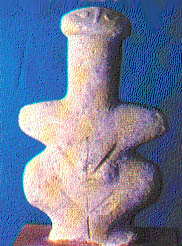
Cyprus
in Chalcolitic Age
 The period of some 1,500 years from about 4,000 to 2,500 B.C. witnessed
unprecedented developments in the history of Cyprus. There is clear
evidence for a significant growth in population and the emergence of social ranking.
The period of some 1,500 years from about 4,000 to 2,500 B.C. witnessed
unprecedented developments in the history of Cyprus. There is clear
evidence for a significant growth in population and the emergence of social ranking.
Copper was used for the first time on the island whose
later prosperity and very name were to become synonymous with that
enviable resource. Metallurgy and social hierarchies have often brought
conflict with them, yet fortifications and weaponry were entirely lacking
in this period.
Throughout the island, settlements of varied size, none of which could
be classed as urban centres, consisted of novel circular buildings that
strike one as anachronistic insofar as there had been a tendency to
rectangularity in the preceding Neolithic period. Once established,
this circular architecture remained the norm for over a millennium. Amidst
these innovating and conserving tendencies there arose highly distinctive
sculptural traditions that mark the zenith of artistic achievement in
Cyprus before the Bronze Age.
 Despite the evidence for occasional overseas
contacts, the islands flourishing Erimi Culture, so named after a type-size
near the south coast, remained essentially unaffected by foreign influence.
Recent research has demonstrated that the conventional division of this
lengthy epoch into periods known as Chalcolitic I and II is no longer
capable of satisfactorily encompassing all the evidence, and hence some
modification is called for. In particular, we need to take into account
the discovery of a formative stage (which would only be vaguely discerned
at the key site of Erimi) and much better defined post-Erimi stage. So
distinctive are these episodes that, without wishing unduly to separate
what was essentially a cultural continuum, it will be useful to refine
the traditional scheme proposed by P. Dikaios into Early, Middle, and
Late
Chalcolitic periods. Such a refinement, it should be emphasized, is
necessary if we are to grasp the causes of change and evolution in what
must be regarded as one of the most distinctive and artistically prolific
prehistoric societies of the Mediterranean region.
Despite the evidence for occasional overseas
contacts, the islands flourishing Erimi Culture, so named after a type-size
near the south coast, remained essentially unaffected by foreign influence.
Recent research has demonstrated that the conventional division of this
lengthy epoch into periods known as Chalcolitic I and II is no longer
capable of satisfactorily encompassing all the evidence, and hence some
modification is called for. In particular, we need to take into account
the discovery of a formative stage (which would only be vaguely discerned
at the key site of Erimi) and much better defined post-Erimi stage. So
distinctive are these episodes that, without wishing unduly to separate
what was essentially a cultural continuum, it will be useful to refine
the traditional scheme proposed by P. Dikaios into Early, Middle, and
Late
Chalcolitic periods. Such a refinement, it should be emphasized, is
necessary if we are to grasp the causes of change and evolution in what
must be regarded as one of the most distinctive and artistically prolific
prehistoric societies of the Mediterranean region.
It should also be
stressed that because so few sites of this neglected period have been
investigated, any reconstruction must still be regarded as tentative.
